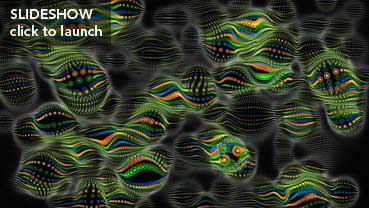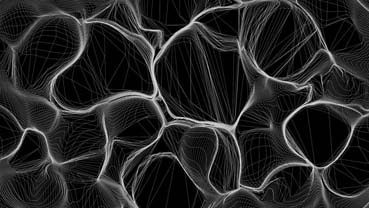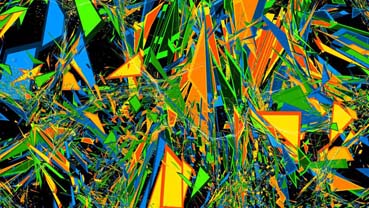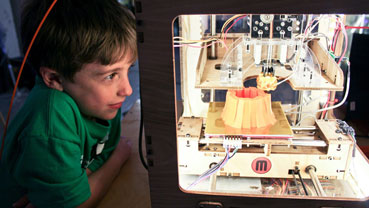Generator Everything
Bruce Sterling July 21, 2011
Marx said that men make their own history—but men don't get to select the circumstances in which history is made. That's what it's like to be a “generative artist”—you have the productive capacity to generate incredible profusions of artistic material. Primeval amounts of weird beauty, volcanic gushes of awesome sight and sound. But you don't get to generate the art world. The art world was here already.
The art world lacks pull-down menus, and it has no selector preferences. To quote Marx again—I rarely do that, and I'm kind of enjoying it—it's a “tradition of all dead generations that weighs like a nightmare on the brains of the living.” Whereas modern generative art is, as Marius Watz likes to frame it, “Generator.x.”
That variable (X) is arbitrary. That's the joy and the freedom of generation, that's what is so different and contemporary about it. It's not artistically arbitrary, like “I can paint anything I please”—it's arbitrary in the mathematical sense. The generated (X) can be most anything. Anything that can be framed within computational logic. Anything subject to algorithms. Anything that is procedural, parametric, performative. Anything.
Computer graphics grew up in Hollywood, at the knee of the analog film business. The moguls called that little digital toddler a "special effect." Its original business was simulating movie props—mimicking analog reality. Yes, it was expensive at first, but it was cheaper than huge sets and better looking than rubber monsters. So that foster child-star's first interest was in Hollywood pretense, in being something that, in truth, it really wasn't.
Early computer graphics had a cousin in the music scene, the music synthesizer. Early synths came with labeled presets installed, so that the happy buyer could simply press one magic button and get a “flute,” a “piano,” a “guitar.” They were fakes of course. They were young and cheesy and jaggy and crude. They were just “effects,” and the eye saw that, the ear heard that. They were ugly ducklings, because they were black swans.
The grand quest of that generation of software engineers was to make those fakes as convincing as technically possible. Digital effects aspired to seem analog “real.” They were forbidden to appear as they really were. To appear naked, as a potent mechanical software process, a tangled nexus of command-lines, running on a chip.
It was always assumed, immediately, unthinkingly, as an article of faith, that nobody wanted to simply see and hear the software, processing. However, at any Marius Watz exhibit, that's what one sees. “Processuality” is on display. This is truth over simulation.
Certain human aspects are pretty much guaranteed: If Marius Watz programmed it, then it is going to be vivid, it's going to be crisp, spiky and angular; it will be fast, bright and noisy, and there's going to be a whole, whole lot of it (he calls this “visual hedonism”).
The process will likely look as complicated and ornery as a grown, living organism—something like coral, or cactus, or a poisonous squid—while still appearing profoundly unnatural (the “neon organic”).
It will be doing many graphical, highly animated things that are physically impossible for any hand or set of human hands to ever draw (“beyond the limits of traditional production”).
It will be violently demonstrating imagery beyond the ability of the human mind to conceive (“computational creativity as the truly alien”).
So the display of Watz art will be—how does one put this? —sensually challenging. It may be, at times, almost impossible to watch. That was his choice.
In the Generator.x philosophy, the generative code is the rock-solid core of the effort, it is the frank expression of the artist's will. It's not “film,” because it's software. It's not “special” or an “effect”—what was once an “effect” has conquered the screen completely; it's become the means of production.
It's quite like that especially pure and harsh form of techno music where all the mummified remnants of analog music—the instrumental samples, the drum breakbeats, the gaseous diva vocals— have been kicked aside and cremated.
The generative artist designs a process. The material is code. Code is a series of scripted commands. Code is dynamic, variable, adaptable. Code has fantastic capacity, but code also has three major, crucial, even terrible artistic problems.
1. One has to start. 2. One has to run. And 3. One has to stop.
It's hard to start, because it's hard to know to what end a generative process should exist. Why make it at all? Why does this “process” exist, what end does it serve? Why am I, the artist, suffering this?
There are various answers to this—few are entirely convincing. Perhaps the most intriguing is that "generative processes" are already going on all around us. There have always been "processes" that were rules-bound and physical and natural, but without computers, we were unable to perceive them as "processes."
The purest exponent of this approach is probably Watz's colleague Jared Tarbell, a New Mexico naturalist who is obsessed with the complex graphic textures of sandstone, bark, clouds and lichen. Tarbell doesn't so much “simulate“ the desert as attempt to deconstruct it. With remarkable effect.
The beauty of flurrying snow, the hypnotic quality of firelight —that's “processuality.”
Complex sets of data can be tamed for the human sensorium by being transformed into graphic structures—that is called “information visualization.” Many toolsets have been created for this practical end, and they can be bent to other forms of graphic expression. Marius Watz likes to “visualize“ music. More recently, Watz has been sculpting music, transforming digital music into three-dimensional objects. If “architecture is frozen music,” then this is frozen music as architecture.
Then there's that second major creative problem, which is running the code. A generative process has to run in order to become; otherwise, it's like sheet music that is never played.
One precursor of generative art used to hack sheet music—he was Conlon Noncarrow, who composed strange dirges for player pianos by cutting holes into paper scrolls with razor blades. Later Noncarrow became the guru of Jaron Lanier, the founder of “Virtual Reality.” There's quite a tangled web of influence behind the scenes of generative art. Marius Watz is a historian of these matters.
However, there's a nexus of hells here, a labyrinth of false starts and forgotten explorations. When code itself becomes the major object of artistic interest, it can consume all intention, all creative energy, invisibly and indefinitely. It also has a short shelf life, because machinery dies fast.
Writing prose—like writing this essay—is an expression of thought. A completed sentence is a complete thought. A paragraph is a series of thoughts that are bundled around one topic. Eventually one naturally stops writing, because human attention must turn to something else. The subject is exhausted of interest. You wrote it, someone read it, the point is made, the moral is clear; it's just done.
Writing software, by stark and dreadful contrast, is an expression of will. Software is not ruminative, expressive and “thoughtful,” but a taut set of intent, deliberate commands: DO THIS, DO THAT. IF THIS, THEN DO THAT.
Globs of software commands can accumulate in hundreds, millions, tens of millions of lines. Masterful coders type heaps of code called "tools" that are assembled in entire “libraries.” That creative grind is potentially endless. Of course all code is inherently hard to write and is always buggy at first, but the "running" problem gets worse. No piece of code can ever be perfected, because software languages aren't perfect. The fragile machinery that supports the code is always in a state of flux—any master art coder has already buried generations of computers. You run fast to stand still.
The computer industry is itself a generative process: It keeps ramifying, endlessly, with its own interior logic. There's just no end to it. It ate Hollywood, it ate the music industry. The black swan's wingbeats can buffet the world.
That's the third major problem of generative art: Ending it. Ending the process, stamping it “finished,” calling it “art,” and walking away. This task is so exceedingly difficult that it's often ignored entirely.
Many generative artists have websites that contain little webtoys, “interactive applets.” Sometimes these toy artworks are sold as iPhone apps, as thumb candy, as eye candy. But they're not “games.” They look playful, but there's no score and no victory; there is, in short, no end to them.
There are likely to be buttons and slider bars to adjust the parameters. There will always be a swift way to click and start all over. They're commonly bright, plastic-looking and attractive, like a wading-pond for a 3-year-old. But, as artworks, they are permanently unfinished. Somewhere behind that simple graphic interface, behind that little wading pool where the happy interactor can splash in glee, is the code that produced it. That code is as deep and sticky as the La Brea Tar Pits.
Generative art can be like gardening; one plants seeds, one tills the field, one kills bugs, and one patiently hopes for some successful harvest. It can also be like beachcombing: the vast uneasy ocean of possible form will belch up some eye-catching driftwood. If you wander the beach. Every day.
But gardens generate weeds, while the ocean teems with polluted debris. It may look easy, that immaterial typing and clicking, but it can be a melancholy enterprise. All that boundless wading and weeding, hoping to find the end-moment, hoping to find the climactic trophy that states, convincingly: Here it is, look how beautiful this is, see, people, this is what my immaterial struggle was all about.
Because the truth is that generative art is never about the generated artwork. That's just the hard copy, a kind of material evidence, best suited for skeptics. The public “artwork,” the effort framed as an artwork, the artifact that survives its maker, can be many things. It can be “film.”
Or it can be music. Or music that is graphically transformed into film. It can also be machine-knitted fabric patterns. Or screensavers, or websites. Or chiseled plywood. Or drill-scarred medium-density fiberboard. It can be racks of laser-cut Plexiglass. It can be Lovecraftian knickknacks squeezed out in computer-controlled oozings of molten plastic, from a “library” of "tools" created by the “MakerBot Artist-in-Residence.” The MakerBot Artist-in-Residence is, by no coincidence, Marius Watz.
He'd become the Sorcerer's Apprentice—if he wasn't, in point of fact, the Sorcerer.
# # #
Bruce Sterling is a novelist, tech blogger and sometime design teacher who is commonly seen in Turin, Belgrade and Austin.
Marius Watz: Automatic Writing, July 22–August 17, Superfrog Gallery at New People, 1746 Post Street (Webster/Buchannan). Exhibition, July 22–August 17. Opening reception July 22, 6:00–9:00 pm. Gallery hours: Wednesday–Sunday, 12:00–6:00 pm. 3-D printed sculptures from the artist’s recent MakerBot residency in. New York and the video Electro Plastique #1, a time-based visual homage to the Op artist Victor Vasarely. Artist Talk, Tuesday, July 26. 7:00 pm, free admission. Watz will speak about his working concepts and methods, followed by a Q&A. Master Class, Wednesday, July 27, Creative Code: Introduction to Generative Systems with Processing. 7:00 pm, $15 SFFS members / $20 general. Watz will introduce the conceptual and practical principles of generative systems and creative coding practices using the popular open source tool Processing.


-
Oct 6, 2011
Thursday
Mill Valley Brings Oscar Contenders Close to Home
Mill Valley amps up the star wattage in its annual mix of local, international titles.

-
Oct 4, 2011
Tuesday
The Facts Behind Great Fiction
The path to authentic storytelling lies in research.

-
Sep 30, 2011
Friday
Gordon-Levitt's Chances Better than '50/50'
Up-and-comer Joseph Gordon-Levitt is so good he compensates for the cancer comedy's shortcomings, even if he can't erase them.

-
Sep 22, 2011
Thursday
SFFS's Hong Kong Cinema Series Brings Fan Fare to New Screen
Audience-engaging stories in a variety of genres highlight SFFS's inaugural Hong Kong Cinema weekend.

-
Sep 18, 2011
Sunday
Dark Thoughts Fill TIFF’s Lightbox
Sex-filled fictions dominate Toronto International Film Festival; eclectic docs inspire action.

-
Sep 16, 2011
Friday
Tiffany Shlain Connects the Dots
With 'Connected,' Tiffany Shlain weaves hope into a high risk story.

-
Sep 13, 2011
Tuesday
He-Men Command Belief in MMA Film 'Warrior'
Gavin O'Connor does a remarkable job making his two-and-a-half-hour fight film gritty, involving and as credible as humanly possible.

-
Sep 2, 2011
Friday
Telluride’s 38th Festival Underway in Colorado
Berkeley-programmed Festival is a favorite for cinephiles; features Caetano Veloso as 2011 Guest Director.


































